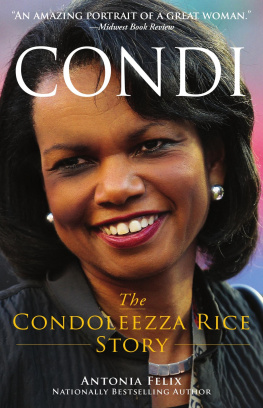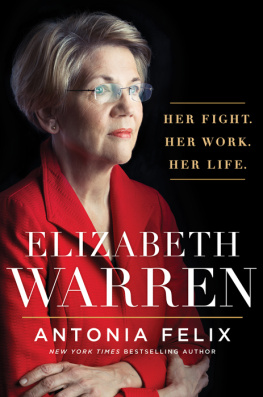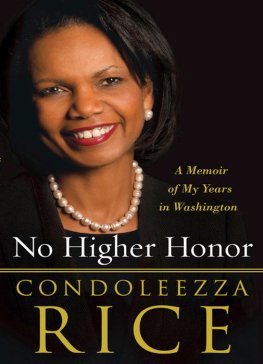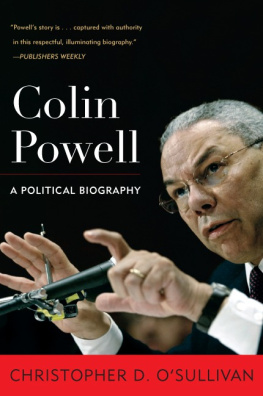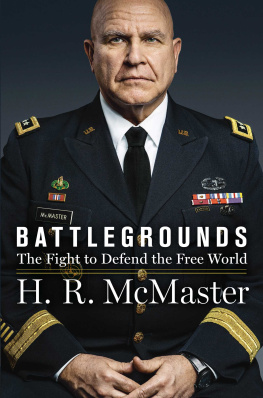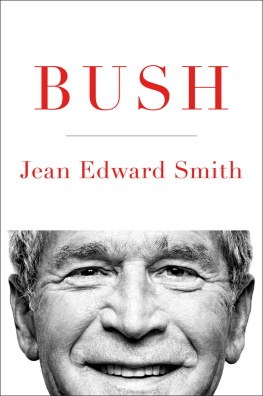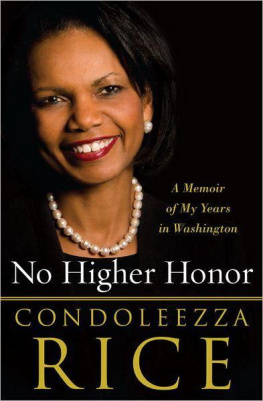Table of Contents
To Maria Yeliseyeva, my Russian sister
HENRY, SORRY TO TELL YOU THIS, BUT ITS NO LONGER A FRATERNITY.
Newly appointed Secretary of State Madeleine Albright to Henry Kissinger, 1997
ACKNOWLEDGMENTS

There are many people to thank for their vital and generous contributions to this book. I am grateful to Clara Bailey Rice of Palo Alto, California, for taking the time to speak to me about her stepdaughter. My heart goes out to all the warm, gracious, and considerate people who made my research in Birmingham so enlightening and productive, including Miss Juliemma Smith for her wonderful conversations and guided tour of Birminghams Westminster Presbyterian Church and Titusville, as well as to Westminsters Reverend William Jones and Annette Cooper. Special thanks to my other Birmingham guide, Pam King, who conducted a fascinating tour and generously shared her expertise of the citys history. It was also a pleasure and an honor to receive a civil rights tour from distinguished University of Alabama Professor Jack Davis, whom I also thank for the literary football analogy sources. I also thank Birmingham ladies Margaret Cheatham and Shirley Epps for their words, their time, and their efforts.
I am deeply indebted to Deborah Carson for her enormously important input. It was a great pleasure to meet one of Condis oldest friends.
My deep appreciation goes to Rebecca Laurie of the University of Denvers Communication Department for her diligent work in tracking down a vast amount of information for me. Thank you, Professor Karen Feste at the University of Denver, for your generous interview. And warm thanks to all the Rice family friends in Denver: Darcy Taylor, Russ and Margaret Wehner, and Reverend Richard Hutchison, as well as Condoleezzas former teachers at St. Marys, Sister Sylvia Pautler, and Therese Saracino.
Most of what I learned about Condoleezzas graduate work at Notre Dame I owe to the generosity of her former professor there, Dr. George Brinkley. I wish him a wonderful continued retirement.
Many thanks to Paul Brest, president of the Hewlett Foundation, and John Raisian, director of the Hoover Institution, for taking the time for interviews. I am also grateful to Professors George Barth and John Ferejohn of Stanford University for their insightful comments. It was great talking to Condoleezzas former workout coach at Stanford, Mark Wateska, and I appreciate the thoughtful correspondence I received from Professor Gail Lapidus, Robby Laitos, Jim Copland, and Jason Gailie. Thanks to Professor Albert Cannella for providing key insights about womens paths to corporate boards. And thank you, Dmitri Gerasamenko, for sharing your compelling personal stories about Russian urban life.
This project would not have been possible without the excellent research work of Sandra Upson at Stanford and Shannon Berning at Newmarket Press. I also extend warmest thanks to Keith Hollaman, my editor, and Esther Margolis, the president of Newmarket, for their enthusiasm and support and for creating such an author-friendly publishing house. Your patience and kindness is deeply appreciated. And, as always, love to my husband Stanford for all his support, encouragement, and late-night readings.
The input of those mentioned, as well as information gleaned from scores of previously published interviews and articles by and about Dr. Condoleezza Rice, has allowed me to present the first biography of one of Americas most prominent foreign policy officialsand perhaps one of the most famous black women in the world. Dr. Rice has made history by being named the first female national security advisor and the second black person to hold that post (General Colin Powell was the first), and delving into her life story has been an inspiring and highly informative experience. I have been inspired by the Rice/Ray family legacy and how Dr. Rice carries that inheritance into the world with her own brand of passion and commitment. I have been informed about the realities of growing up black in Birmingham in the 1950s and 1960s and the differing types of black experience during that struggle. And I have also been stimulated by insights into the inner workings of academia, policy making, corporate boards, and other areas that are covered in Dr. Rices life story.
My intent has been to focus on Dr. Rices family, childhood, education, and career path rather than to construct a commentary on her political and policy views. It has been my goal to create a comprehensive portrait of the person who has the presidents ear perhaps more than anyone else in the White Housea black woman who has risen to the top in a field traditionally dominated by white men and who has experienced firsthand some of the nations darkest and brightest moments.
PRELUDE
WHEN Condoleezza Rice was ten years old, her parents took her on a trip to Washington, D.C. For John and Angelena Rice, whom Condoleezza has described as education evangelists, the nations capital was the ultimate vacation destinationso much history to discover, so many museums to explore, so much to inspire a young mind. Strolling along Pennsylvania Avenue, they stopped to peer through the gate in front of the White House. Condoleezza stared quietly at the pillared faade. The trio stood in silence until the girl turned to her father and said, Daddy, Im barred out of there now because of the color of my skin. But one day, Ill be in that house.
Not only was she a precocious child, but prophetic, too. Twenty-five years later she was working fourteen-hour days as President George H. W. Bushs top advisor on the Soviet Union, helping write U.S. policy through the unification of Germany and the end of the Cold War. Eleven years after her two-year stint in that administration, she reentered the White House as President George W. Bushs national security advisor.
During George W.s presidential campaign, Jay Nordlinger predicted in the National Review that whatever post Condoleezza Rice received in the administration she would be rock-star biga household name. She has not yet appeared on any billboards in Times Square, but her celebrity status is on the rise. This became most evident after September 11, 2001, when she was appointed one of the primary White House spokespeople on the war on terrorism. Her visibility has also been enhanced by ritual appearances on the Sunday Washington talk shows and through lengthy profiles in magazines such as Vogue, George (now defunct), and O: The Oprah Magazine. And in some parts of the country, she has been a star for quite some time. In East Palo Alto, California, for example, where she cofounded an after-school academy for children from underfunded school districts, she is a local hero. And in the field of Soviet studies, her chosen specialty since first hearing a lecture on Stalin as a junior in college, she is a nationally renowned expert and scholar.
Condoleezza Rice has two passions in her life: music and Russia. This book explores her familys musical roots, which formed both her name and her goal of becoming a concert pianist. That part of her story took a sudden detour in her teen years when she decided she did not have what it takes to enter the very small ranks of the concert world. She made a sharp turn when she heard a charismatic professor (the father of former Secretary of State Madeleine Albright) lecture on the Soviet Union, and entered that oddly familiar and captivating territory, never to turn back.

